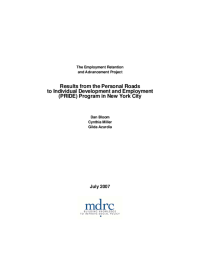Results from the Personal Roads to Individual Development and Employment (PRIDE) Program in New York City
The Employment Retention and Advancement Project
Many states are searching for ways to promote employment among welfare recipients facing serious barriers to work. This report presents interim results from an evaluation of New York City’s Personal Roads to Individual Development and Employment (PRIDE) program, a large-scale welfare-to-work program for recipients with work-limiting medical or mental health conditions. The PRIDE evaluation is part of the Employment Retention and Advancement (ERA) project, which was conceived by the Administration for Children and Families (ACF) in the U.S. Department of Health and Human Services. The ERA project is being conducted by MDRC under contract to ACF, with additional funding from the U.S. Department of Labor.
PRIDE operated from 1999 to 2004, serving more than 30,000 people, before it was replaced by a new program that builds on the PRIDE model. PRIDE started with an in-depth assessment of participants’ work and education history and their medical conditions. The program’s employment services were similar to those in New York’s regular welfare-to-work program — emphasizing unpaid work experience, education, and job placement assistance — but, in PRIDE, staff tried to ensure that participants were assigned to activities that took account of their medical conditions (most commonly, orthopedic problems, mental health conditions, asthma, or high blood pressure).
PRIDE is being evaluated using a random assignment research design: More than 3,000 eligible recipients were assigned, through a lottery-like process, to the PRIDE group, which was required to participate in the program in accordance with citywide rules, or to the control group, which was neither required nor permitted to participate in PRIDE but could seek out other services.
Key Findings
- The PRIDE group was substantially more likely than the control group to participate in work experience and job search activities. PRIDE was an ambitious program involving complex linkages among several agencies. Despite some operational difficulties, the program identified and engaged a large number of recipients who had previously been exempt from work requirements. At the same time, a large proportion of the PRIDE group — about one-third — was sanctioned (that is, they had welfare benefits reduced) as a penalty for noncompliance, far higher than the control group figure of about 8 percent.
- PRIDE generated increases in employment. For example, 34 percent of the PRIDE group worked in a job covered by unemployment insurance within two years after entering the study, compared with 27 percent of the control group. While it is impressive that PRIDE was able to increase employment for a very disadvantaged target group, about two-thirds of the PRIDE group never worked during the two-year period.
- PRIDE significantly reduced welfare payments. The PRIDE group received $818 less (about 7 percent less) in cash assistance than the control group over the two years. The reduction was driven partly by the employment gains and partly by the high rate of sanctioning.
MDRC will continue to track both groups and will report longer-term results in the future. These early findings show that it is feasible to operate a large-scale mandatory work program for recipients with health-related employment barriers. Moreover, PRIDE increased employment. However, there are also reasons for caution: Most people in the PRIDE group did not go to work, and many were sanctioned for failing to participate in the program.






